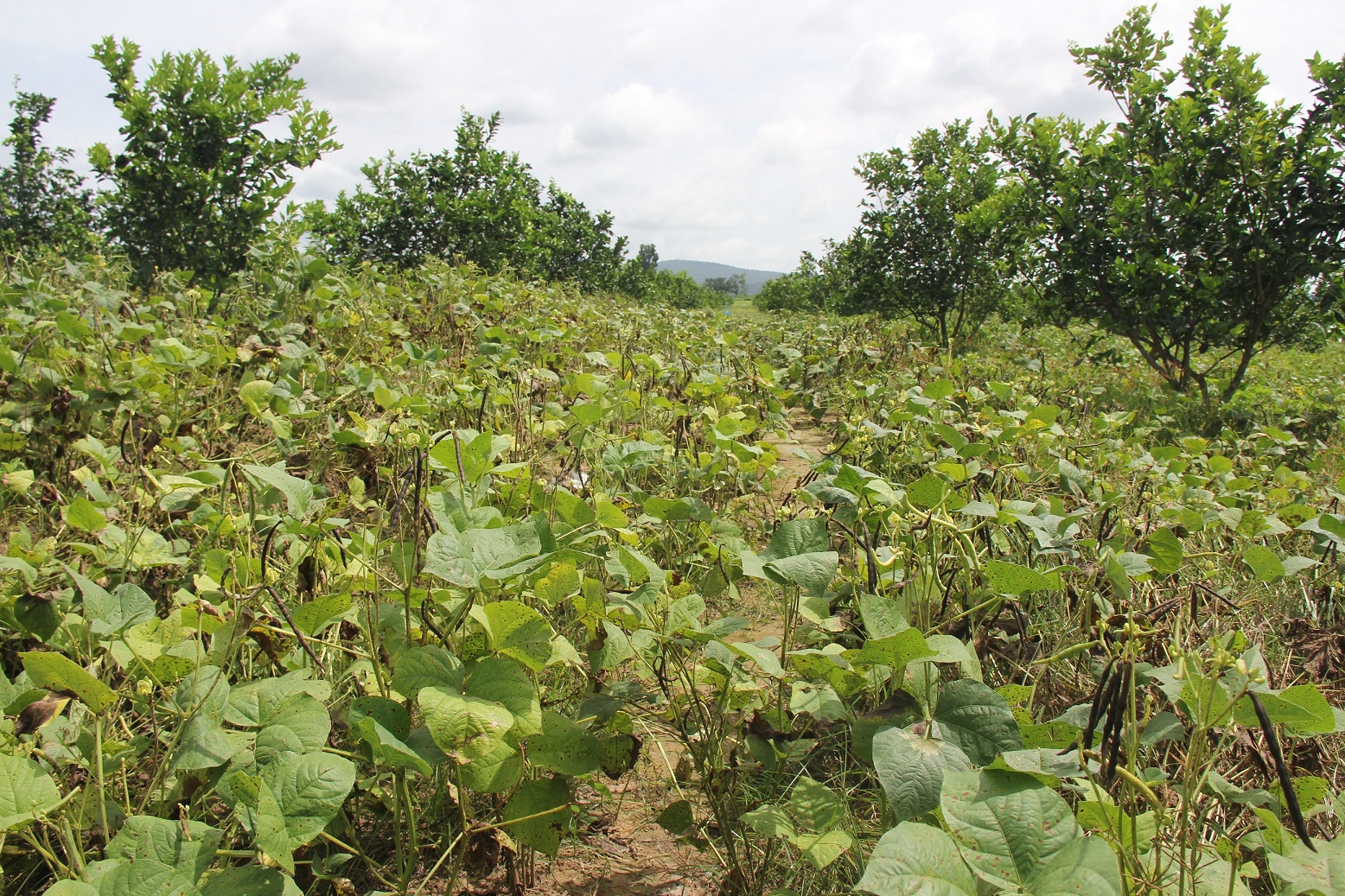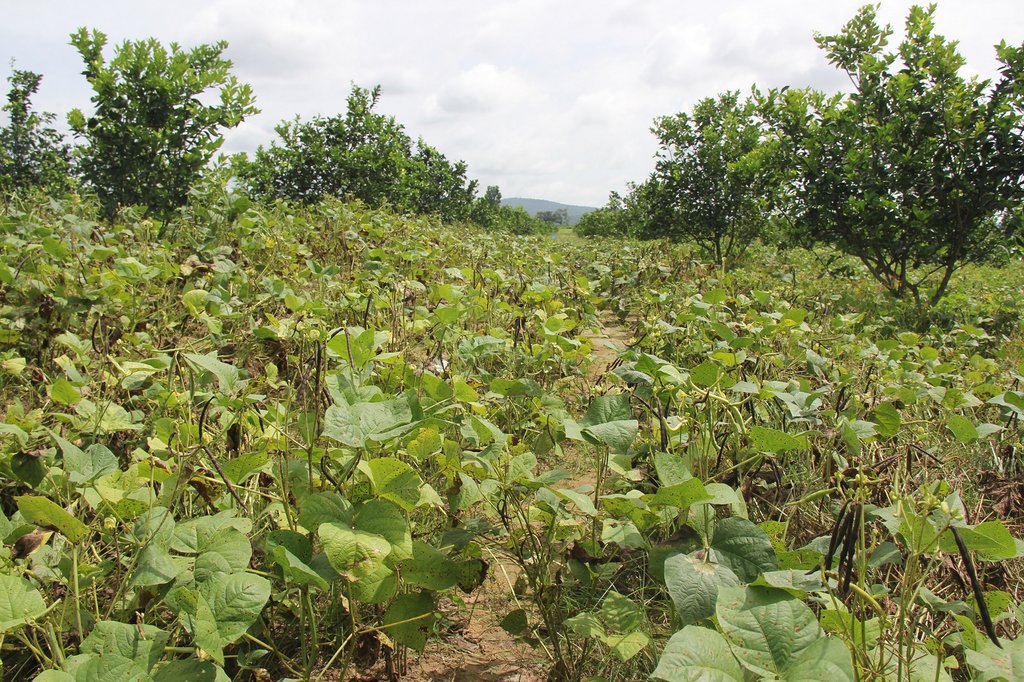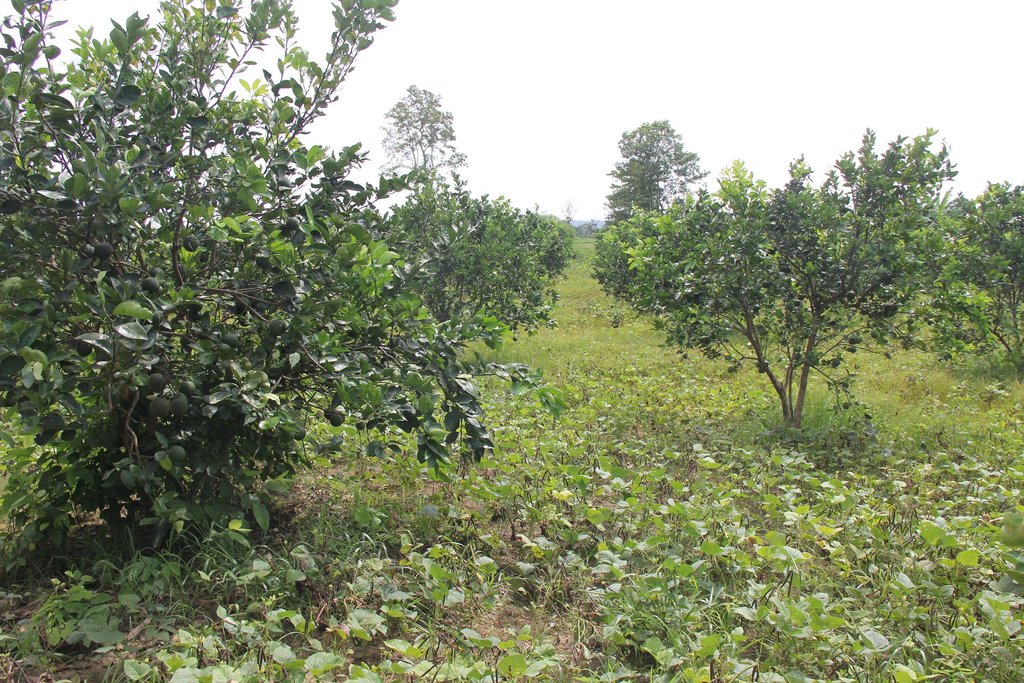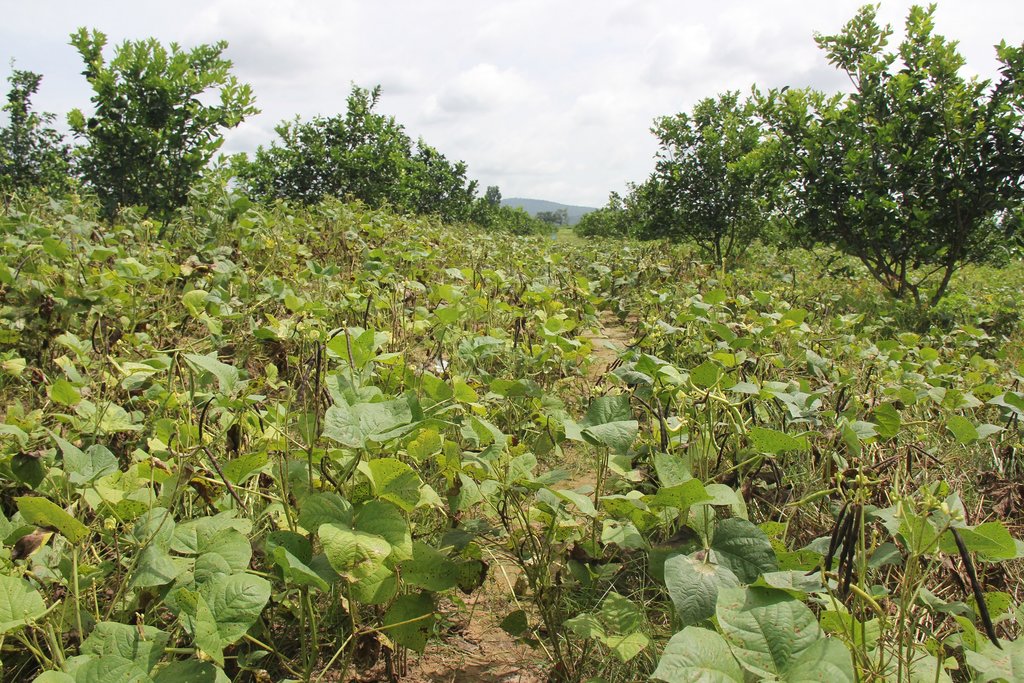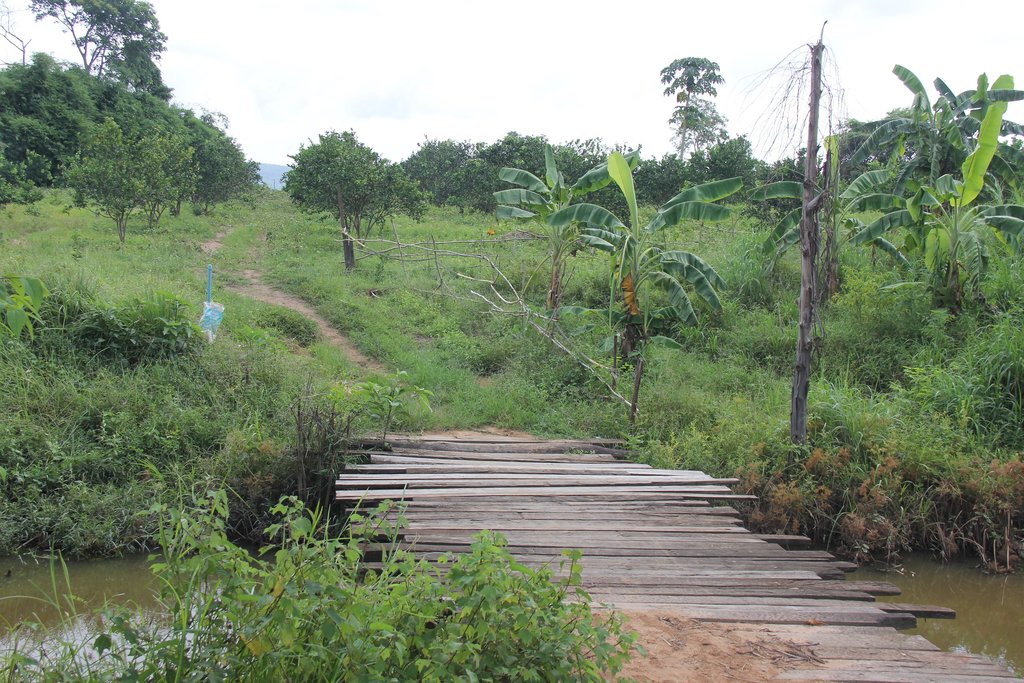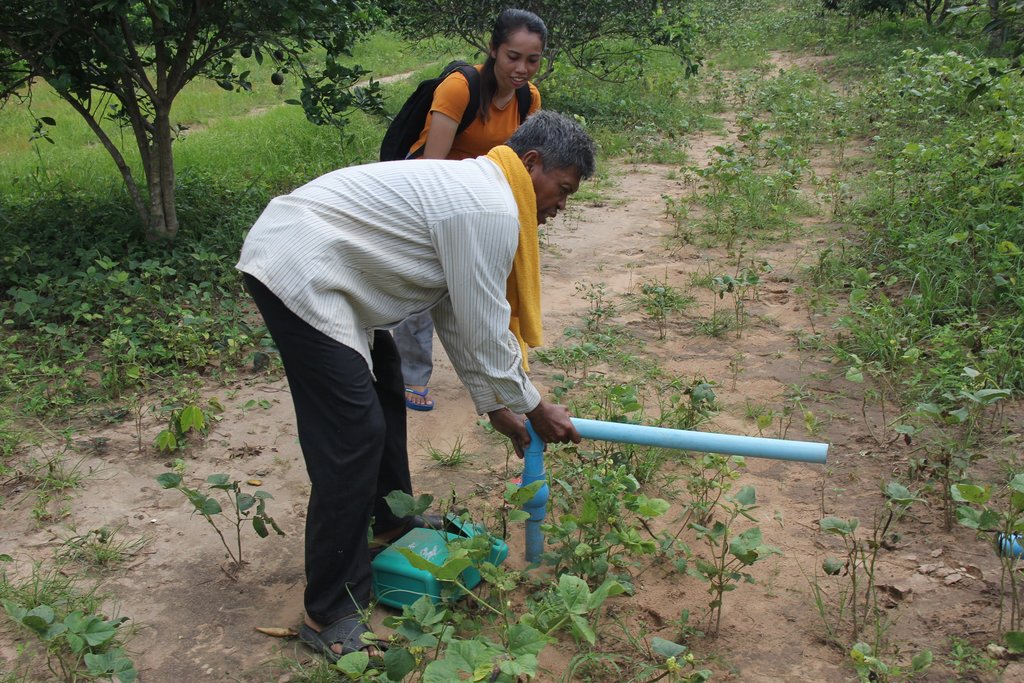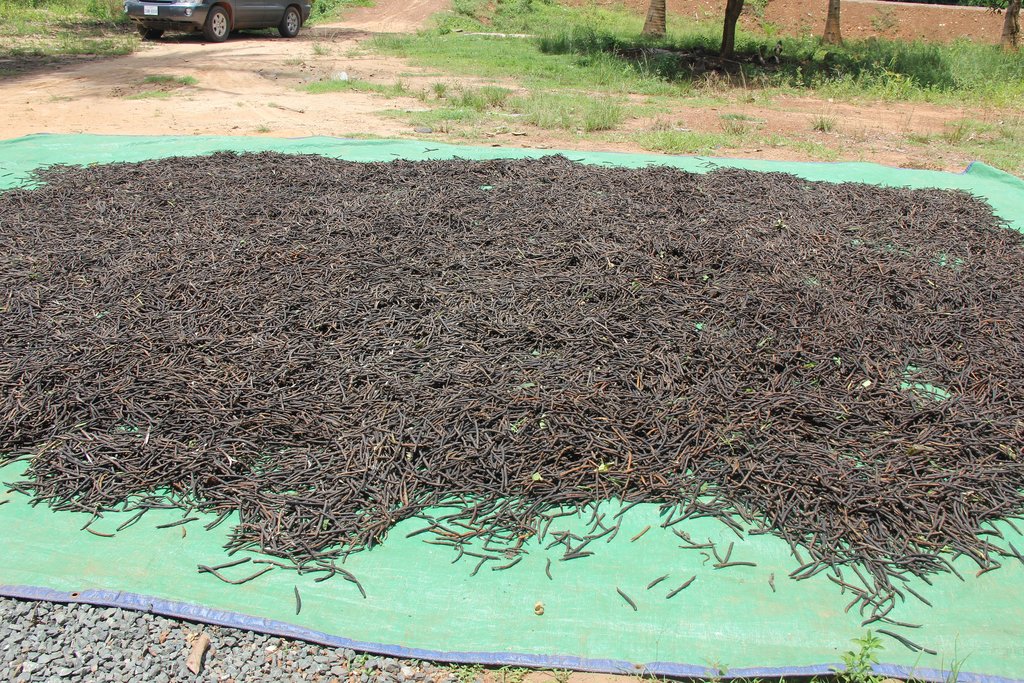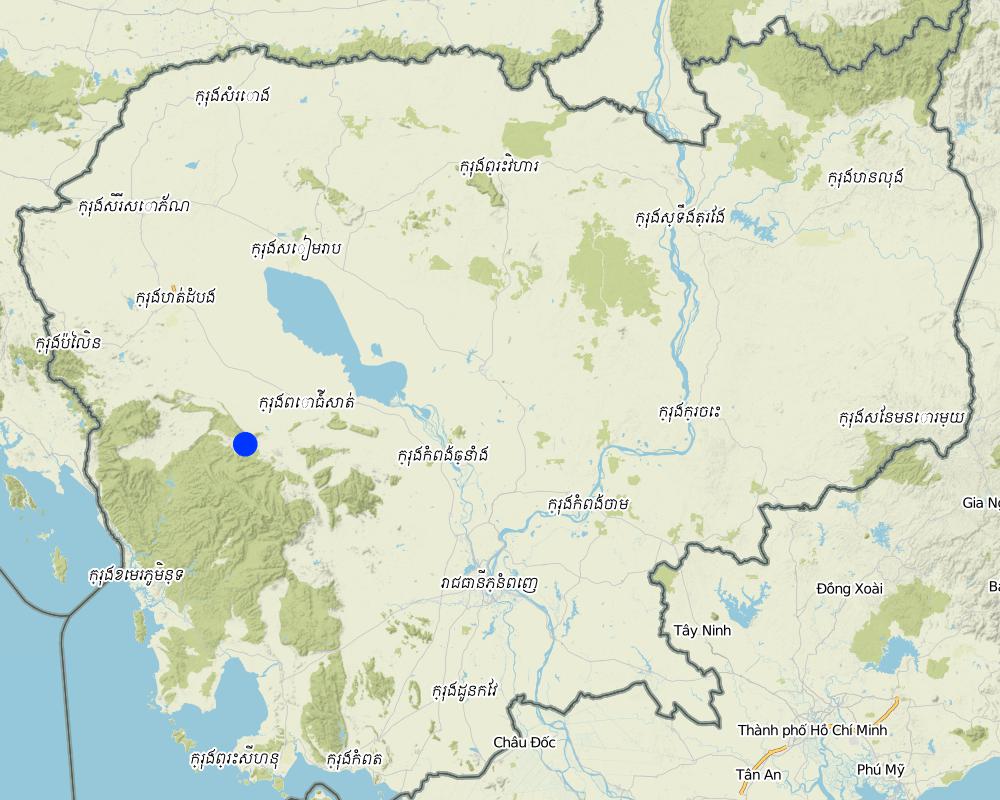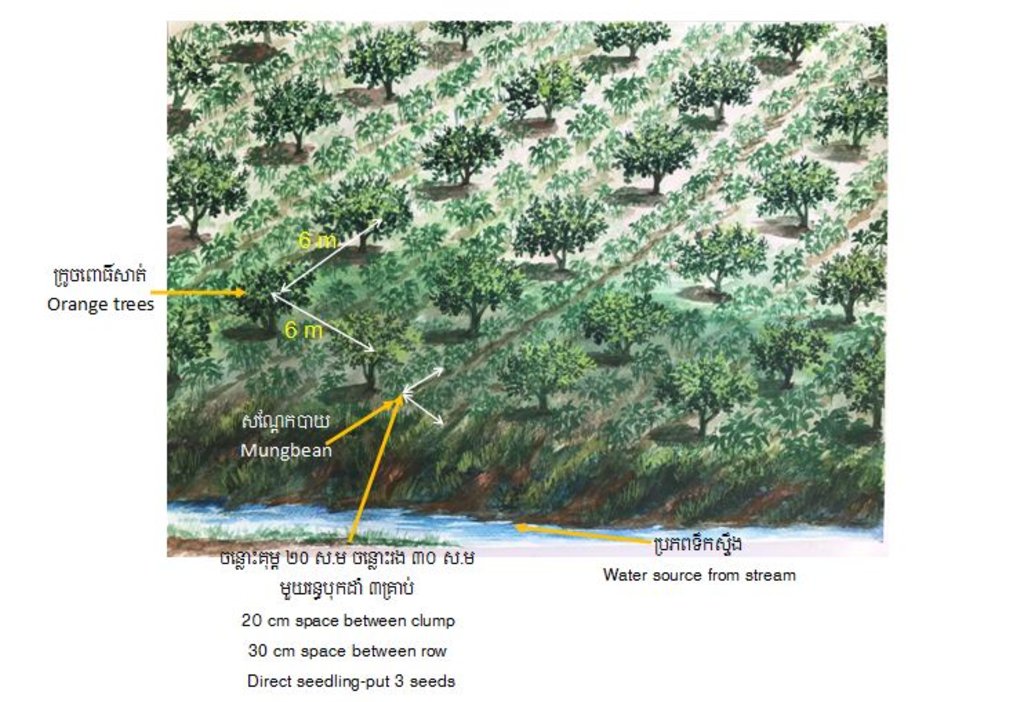Intercropping of orange trees with mungbean in mountainous areas [柬埔寨]
- 创建:
- 更新:
- 编制者: Navin Chea
- 编辑者: Sophea Tim, Sok Pheak
- 审查者: Nimul CHUN, SO Than, Ursula Gaemperli, Alexandra Gavilano
Intercropping
technologies_3146 - 柬埔寨
查看章节
全部展开 全部收起1. 一般信息
1.2 参与该技术评估和文件编制的资源人员和机构的联系方式
关键资源人
土地使用者:
Chea Sarith
Land User
柬埔寨
Acting Chief of District Office of Agriculture, Forestry and Fisheries, Phnum Kravanh:
Doung Phanny
District Office of Agriculture, Forestry and Fisheries, Phnum Kravanh.
柬埔寨
Chief Office of Agricultural Extension at Provincial Department of Agriculture, Forestry and Fisheries, Pursat:
Chief of District Office of Agriculture, Forestry and Fisheries , Bakan:
Agronomic Official at District Office of Agriculture, Forestry and Fisheries , Kandieng:
Seng Kompheak
District Office of Agriculture, Forestry and Fisheries , Kandieng
柬埔寨
有助于对技术进行记录/评估的项目名称(如相关)
Scaling-up SLM practices by smallholder farmers (IFAD)有助于对技术进行记录/评估的机构名称(如相关)
Royal University of Agriculture (RUA) - 柬埔寨1.3 关于使用通过WOCAT记录的数据的条件
编制者和关键资源人员接受有关使用通过WOCAT记录数据的条件。:
是
1.4 所述技术的可持续性声明
这里所描述的技术在土地退化方面是否存在问题,导致无法被认为是一种可持续的土地管理技术?:
否
2. SLM技术的说明
2.1 技术简介
技术定义:
Intercropping of mungbean between orange trees improves soil fertility and generates income before the orange trees bear fruit.
2.2 技术的详细说明
说明:
Agroforestry is a farming practice that can involve growing of a mixture of woody perennials like trees, shrubs, palms, bamboos, etc. with crops and/or animals, on the same land-management units. Agroforestry systems play an important role in ecological and economical interactions between the different land use components (Lundgren and Raintree, 1982). It represents an interface between agriculture and forestry, and encompasses mixed land-use practices. Agroforestry systems are composed of three attributes:
1. Productivity (improved tree products, yields of associated crops, reduction of cropping system inputs, and increased labor use efficiency);
2. Sustainability (beneficial effects of woody perennials);
3. Adoptability (MoE/Adaptation Fund/UNEP, 2016).
In Cambodia, mungbean grows throughout the whole year almost, depending on the moisture factor. Mungbean is short maturity crop which can be grown both in sloping upland and in lowland areas. In upland areas farmers usually plant their second crop in August and harvest it in October. Mungbean is a crop that can be grown on many soil types, but grows best on alluvial, sandy, and volcanic soils which well drained containing high levels of nutrients (incl. N, P, K, Ca, Mg) and organic matter (MAFF, 2005). Mungbean crop duration depends on the variety, with short-term, medium-term and long-term being harvested between 60-65 days, 65-75 days, and 75-80 days, respectively.
Mungbean residues can make an active contribution to improvement of soil quality through nitrogen fixation and subsequent incorporation of this nitrogen into the soil after root and nodule degeneration by Rhizobium bacteria. The incorporation of the organic root material also improves the soil structure (MAFF, 2005, Chadha, 2010, IRRI-CIMMYT Alliance, 2009). The taproot of the mungbean can penetrate the soil to a depth of 50-60 centimeters. Sometimes, some land users grow mungbean as a green manure crop specifically to improve soil quality (Tauch Ung, 2010).
Mr. Chea Sarith is one example of land user who practices intercropping of orange trees with mungbean since 2013. The main purpose is to improve soil fertility, to prevent soil erosion, and to generate income before the orange trees provide fruit. In addition, it eases the weed control. After the harvest the farmer leaves the plant residues on the soil to provide organic matter. With the objective not to harm the roots of the orange trees, he avoids tilling the soil. In general, mungbean grows twice a season depending on the rainfall distribution and soil moisture.
The average yield of direct seeded mungbean as an intercrop between orange trees is about 1,200 kg/ha (harvested 3 times per crop). If mungbean is grown as a single crop the yield is usually ranges from 1,300 to 1,400 kg/ha. The market price for mungbean grain is usually about 4,500 to 5,000 Riel/kg.
Before planting orange trees the soil requires two turns of ploughing. After first ploughing the soil should dry during 1-2 months, before it can be ploughed again by a wheel harrow. Orange trees then are planted in rows into pits of 1 m x 1 m, with a depth of 70-80 cm. The spacing between the trees, as well as between the rows is usually 6 meters. Before planting, the orange tree seedlings (bought from outside) are usually kept at the farm site for 15 to 20 days, which to allow them to adapt to the conditions of the growing environment. The farmer installed a water pipe in the underground to irrigate the fruit orchard. The nearby stream serves as water source. After the tree plantation, mungbean is sown by direct seeding on the remaining bare soil. This is done by putting 3 to 4 seeds into the seed holes (3 to 4 cm sowing depth at a plant spacing of 20 cm and a row spacing of 30 cm. After harvest the residues of the mungbean plants are squashed by machine and left to rot on the soil surface until is the next mungbean cycle starts by direct seeding.
2.3 技术照片
2.5 已应用该技术的、本评估所涵盖的国家/地区/地点
国家:
柬埔寨
区域/州/省:
Ongkrong Village, Samrong Commune, Phnum Kravanh District, Pursat Province.
有关地点的进一步说明:
Phnum Kravanh of Cambodia.
具体说明该技术的分布:
- 均匀地分布在一个区域
如果不知道精确的区域,请注明大致覆盖的区域:
- < 0.1 平方千米(10 公顷)
Map
×2.6 实施日期
注明实施年份:
2013
2.7 技术介绍
详细说明该技术是如何引入的:
- 通过土地使用者的创新
- 在实验/研究期间
注释(项目类型等):
Through farmers experience, investigation on cropping and natural fertilizer application.
3. SLM技术的分类
3.1 该技术的主要目的
- 改良生产
- 减少、预防、恢复土地退化
- 创造有益的经济影响
3.2 应用该技术的当前土地利用类型
同一土地单元内混合使用的土地::
是
具体说明混合土地使用(作物/放牧/树木):
- 农林业

农田
- 一年一作
- 乔木与灌木的种植
年作 - 具体指明作物:
- 豆科牧草和豆类 - 豆子
乔木和灌木种植 - 指定作物:
- 柑橘属
每年的生长季节数:
- 1
具体说明:
Orange trees belong to the long lifespan crop which provide fruit at the age of 4 years. The lifespan of getting fruits is approximately 20 years. Then in general, the farmer cuts the trees down and grow it again. However, it depends on the yield it provides. Mungbean can be harvested within two months and half and can be harvested 3 times per crop cycle.
注释:
Orange and mungbean.
3.3 由于技术的实施,土地使用是否发生了变化?
由于技术的实施,土地使用是否发生了变化?:
- 是(请在技术实施前填写以下有关土地利用的问题)

森林/林地
注释:
Degraded forest, soil from termite mound.
3.4 供水
该技术所应用土地的供水:
- 混合雨水灌溉
注释:
There is a stream near the farm for supply the water for orange trees.
3.5 该技术所属的SLM组
- 农业林学
- 改良的地面/植被覆盖
3.6 包含该技术的可持续土地管理措施

农艺措施
- A1:植被和土壤覆盖层
- A3:土壤表面处理

结构措施
- S7:集水/供水/灌溉设备
3.7 该技术强调的主要土地退化类型

土壤风蚀
- Et:表土流失

化学性土壤退化
- Cn:肥力下降和有机质含量下降(非侵蚀所致)

物理性土壤退化
- Pc:压实

生物性退化
- Bc:植被覆盖的减少
- Bl:土壤寿命损失
3.8 防止、减少或恢复土地退化
具体数量名该技术与土地退化有关的目标:
- 防止土地退化
- 修复/恢复严重退化的土地
注释:
The former degraded forest soil was rehabilitated by the rotten residues of the mungbean, the deep penetration of its taproots, and by the nitrogen fixation through the symbiotic association of nitrogen fixing bacteria in the nodular roots of the mungbean. Thus, the soil structure and the soil fertility were improved little by little.
4. 技术规范、实施活动、投入和成本
4.1 该技术的技术图纸
技术规范(与技术图纸相关):
The area of implementing this technology is 4 hectares with 1096 orange trees. The pit of planting orange trees is 1m x 1m, with a depth of 70-80 cm. The spacing between trees and between rows is usually 6 meters to get enough sunlight. The mungbean is planted by direct seedling by inserting 3 to 4 seeds per hole (the hole is 3-4 cm in depth). The spacing between the holes is 20 cm and the row spacing is 30 cm. The farmer of this farm also installed an irrigation system by setting up a pipe under the ground.
作者:
Mr. Khoun Sophal
日期:
05/07/2017
4.2 有关投入和成本计算的一般信息
具体说明成本和投入是如何计算的:
- 每个技术区域
注明尺寸和面积单位:
4 hectares
其它/国家货币(具体说明):
KHR (Riel)
如相关,注明美元与当地货币的汇率(例如1美元=79.9巴西雷亚尔):1美元=:
4000.0
注明雇用劳工的每日平均工资成本:
20000
4.3 技术建立活动
| 活动 | 时间(季度) | |
|---|---|---|
| 1. | Clear degraded forest | January |
| 2. | Clear the termite mound to flatten the area | Dry season |
| 3. | Drying the soil by sunlight | Dry season |
| 4. | Buy orange trees and adapt them to the condition of the area | Dry season |
| 5. | Planting orange trees | August |
4.4 技术建立所需要的费用和投入
| 对投入进行具体说明 | 单位 | 数量 | 单位成本 | 每项投入的总成本 | 土地使用者承担的成本% | |
|---|---|---|---|---|---|---|
| 劳动力 | Clear the degraded forest soil | Person-day | 80.0 | 2000.0 | 160000.0 | 100.0 |
| 劳动力 | Collect the residue of forest and then burn | Person-day | 60.0 | 20000.0 | 1200000.0 | 100.0 |
| 劳动力 | Clear 40 termite mounds in 4 hectares | Person-day | 48.0 | 20000.0 | 960000.0 | 100.0 |
| 劳动力 | Hire labor to carry the soil of termite mound to put in the hole of orange tree for planting | Person-day | 180.0 | 20000.0 | 3600000.0 | 100.0 |
| 设备 | Grass cutting marchine | piece | 2.0 | 1200000.0 | 2400000.0 | 100.0 |
| 设备 | Two wheel tractor | piece | 1.0 | 12000000.0 | 12000000.0 | 100.0 |
| 植物材料 | Orange seedlings | seedling | 1026.0 | 6000.0 | 6156000.0 | 100.0 |
| 施工材料 | Pumping machine | piece | 1.0 | 1200000.0 | 1200000.0 | 100.0 |
| 施工材料 | Irrigation system such as big tube, small tube etc | set | 1.0 | 8000000.0 | 8000000.0 | 100.0 |
| 其它 | Planting orange trees | Person-day | 51.0 | 20000.0 | 1020000.0 | 100.0 |
| 其它 | Pesticide sprayer machine | piece | 3.0 | 600000.0 | 1800000.0 | 100.0 |
| 其它 | Spraying pesticide hand pump sprayer | piece | 1.0 | 280000.0 | 280000.0 | 100.0 |
| 技术建立所需总成本 | 38776000.0 | |||||
| 技术建立总成本,美元 | 9694.0 | |||||
4.5 维护/经常性活动
| 活动 | 时间/频率 | |
|---|---|---|
| 1. | Watering during dry season in the first year of planting orange trees | Two times per day during dry season |
| 2. | Spraying pesticides when there is present of insects on orange trees | Spray once time per season |
| 3. | Pruning some branches of orange trees | When the orange trees 2 years (One year cut some branches once time) |
| 4. | Apply organic fertilizer for the orange trees | When the orange trees are 4 years |
| 5. | Spray against weeds | Spray once time per half month. |
| 6. | Spray pesticides on mungbean plants | When mungbean flowering |
| 7. | Direct seeding of mungbean | August |
4.6 维护/经常性活动所需要的费用和投入(每年)
| 对投入进行具体说明 | 单位 | 数量 | 单位成本 | 每项投入的总成本 | 土地使用者承担的成本% | |
|---|---|---|---|---|---|---|
| 劳动力 | Watering the orange trees | Person-day | 11.0 | 20000.0 | 220000.0 | 100.0 |
| 劳动力 | Pruning some branches of orange trees | Person-day | 100.0 | 20000.0 | 2000000.0 | 100.0 |
| 劳动力 | Hire labor to spray pesticides | Person-day | 8.0 | 20000.0 | 160000.0 | 100.0 |
| 劳动力 | Hire labor to harvest mungbean when mature | Person-day | 120.0 | 20000.0 | 2400000.0 | 100.0 |
| 植物材料 | Mungbean seed (1 hectare need 25 kg of mungbean) seeds) | hectare | 4.0 | 312500.0 | 1250000.0 | 100.0 |
| 肥料和杀菌剂 | Pesticides for orange trees | bottle | 4.0 | 40000.0 | 160000.0 | 100.0 |
| 肥料和杀菌剂 | Chemicals for improving of stem of mungbean | package | 60.0 | 1500.0 | 90000.0 | 100.0 |
| 肥料和杀菌剂 | Pesticide to kill worms on mungbean | bottle | 2.0 | 40000.0 | 80000.0 | 100.0 |
| 其它 | Direct seeding of mungbean | Person-day | 56.0 | 20000.0 | 1120000.0 | 100.0 |
| 技术维护所需总成本 | 7480000.0 | |||||
| 技术维护总成本,美元 | 1870.0 | |||||
注释:
The maintenance costs then depend on the age of orange trees. The cost calculation of maintenance of orange trees is for year period, but the the recurrent costs for mungbean cultivation is calculated only for one crop cycle (two months and half).
4.7 影响成本的最重要因素
描述影响成本的最决定性因素:
The establishment of an orange tree orachard requires a lot of money.
5. 自然和人文环境
5.1 气候
年降雨量
- < 250毫米
- 251-500毫米
- 501-750毫米
- 751-1,000毫米
- 1,001-1,500毫米
- 1,501-2,000毫米
- 2,001-3,000毫米
- 3,001-4,000毫米
- > 4,000毫米
指定年平均降雨量(若已知),单位为mm:
1225.70
有关降雨的规范/注释:
In 2015 the annual rainfall is 1225.7 mm, in 2014 is 1128.1 and in 2013 is 1316 mm.
注明所考虑的参考气象站名称:
Ministry of water resources and meteorology, 2015
农业气候带
- 半湿润
5.2 地形
平均坡度:
- 水平(0-2%)
- 缓降(3-5%)
- 平缓(6-10%)
- 滚坡(11-15%)
- 崎岖(16-30%)
- 陡峭(31-60%)
- 非常陡峭(>60%)
地形:
- 高原/平原
- 山脊
- 山坡
- 山地斜坡
- 麓坡
- 谷底
垂直分布带:
- 0-100 m a.s.l.
- 101-500 m a.s.l.
- 501-1,000 m a.s.l.
- 1,001-1,500 m a.s.l.
- 1,501-2,000 m a.s.l.
- 2,001-2,500 m a.s.l.
- 2,501-3,000 m a.s.l.
- 3,001-4,000 m a.s.l.
- > 4,000 m a.s.l.
说明该技术是否专门应用于:
- 不相关
关于地形的注释和进一步规范:
On Phnum Kravanh mountain area.
5.3 土壤
平均土层深度:
- 非常浅(0-20厘米)
- 浅(21-50厘米)
- 中等深度(51-80厘米)
- 深(81-120厘米)
- 非常深(> 120厘米)
土壤质地(表土):
- 粗粒/轻(砂质)
土壤质地(地表以下> 20厘米):
- 粗粒/轻(砂质)
表土有机质:
- 中(1-3%)
如有可能,附上完整的土壤描述或具体说明可用的信息,例如土壤类型、土壤酸碱度、阳离子交换能力、氮、盐度等。:
PH=6
5.4 水资源可用性和质量
地下水位表:
5-50米
地表水的可用性:
好
水质(未处理):
良好饮用水
水的盐度有问题吗?:
否
该区域正在发生洪水吗?:
否
5.5 生物多样性
物种多样性:
- 中等
栖息地多样性:
- 中等
5.6 应用该技术的土地使用者的特征
定栖或游牧:
- 定栖的
生产系统的市场定位:
- 商业/市场
非农收入:
- 低于全部收入的10%
相对财富水平:
- 平均水平
个人或集体:
- 个人/家庭
机械化水平:
- 手工作业
- 机械化/电动
性别:
- 男人
土地使用者的年龄:
- 中年人
5.7 应用该技术的土地使用者使用的平均土地面积
- < 0.5 公顷
- 0.5-1 公顷
- 1-2 公顷
- 2-5公顷
- 5-15公顷
- 15-50公顷
- 50-100公顷
- 100-500公顷
- 500-1,000公顷
- 1,000-10,000公顷
- > 10,000公顷
这被认为是小规模、中规模还是大规模的(参照当地实际情况)?:
- 中等规模的
注释:
The total crop land is 15 hectares.
5.8 土地所有权、土地使用权和水使用权
土地所有权:
- 个人,有命名
土地使用权:
- 个人
用水权:
- 自由进入(无组织)
注释:
There is free access of water stream nearby. He never has water usage conflict.
5.9 进入服务和基础设施的通道
健康:
- 贫瘠
- 适度的
- 好
教育:
- 贫瘠
- 适度的
- 好
技术援助:
- 贫瘠
- 适度的
- 好
就业(例如非农):
- 贫瘠
- 适度的
- 好
市场:
- 贫瘠
- 适度的
- 好
能源:
- 贫瘠
- 适度的
- 好
道路和交通:
- 贫瘠
- 适度的
- 好
饮用水和卫生设施:
- 贫瘠
- 适度的
- 好
金融服务:
- 贫瘠
- 适度的
- 好
6. 影响和结论性说明
6.1 该技术的现场影响
社会经济效应
生产
作物生产
注释/具体说明:
The soil fertility was improved, so that the crop production increased steadily. In addition, the farmer now doesn't grow only orange trees, but he also grows mungbean.
作物质量
注释/具体说明:
The residues of mungbean contain many nutrients, which is suitable for getting good crop quality.
生产故障风险
注释/具体说明:
As the farmer plants more than one crop on the plot now, it reduces the production failure. This means that farmer get income from mungbeans before the orange trees provide fruits. The better weed control also reduces insects, which could be harmful to the crop.
产品多样性
注释/具体说明:
There are mungbean and orange trees, now.
收入和成本
农业投入费用
注释/具体说明:
Reduced chemical fertilizers on orange trees and mungbean, because after harvesting mungbean residues are kept on the soil which is very good green manure for soil.
农业收入
注释/具体说明:
The farm income increases considerably due the intercropping system, as both mungbean and orange trees provide yield. In addition, mungbeans provide yield two times per year. Last but not least , mungbean play a key role as green manure which reduces the input of chemical fertilizers and therefore cost.
工作量
注释/具体说明:
The mungbean and orange tree cultivation does not consume much of labor force because he doesn't have to spend a lot of time for weeding (as instead of weed mungbeans cover the soil now). On the other hand, the farmer mentioned that the orange plantation is time consuming at the beginning, when the orange trees has to be planted. As well the mungbean need more time at the moment when the plot has to be prepared for first direct seedling. But the technology as a whole entails not a lot of maintenance workload as he uses machinery such as pesticide sprayer machine and mungbean squash machine to facilitate the labor.
社会文化影响
食品安全/自给自足
注释/具体说明:
The diversification of the crops (oranges and mungbean) has considerably raised the income and therefore strongly prevent food insecurity situations.
健康状况
注释/具体说明:
The reduction of chemical fertilizer and pesticides provides safer products that improves the health situation. In addition, mungbean and orange fruit deliver many nutrition benefits to human health.
社区机构
注释/具体说明:
He has joined the orange trees community to sell the orange fruits. Many researches are convinced of his success and the tastiness of his oranges; as for example researchers from the District Office of Agriculture, Forestry and Fisheries, Phnum Kravanh, Provincial Department of Agriculture, Forestry and Fisheries, Pursat etc.”
SLM/土地退化知识
注释/具体说明:
By doing the farmer learned that degraded soil can be rehabilitated by the mean of mungbean residues acting as green manure. And from the moment the soil is rehabilitated he can see that this green manure prevents soil degradation at high degree.
生态影响
土壤
土壤水分
注释/具体说明:
Mungbean and orange trees keep the soil moisture, prevent the evaporation to the atmosphere.
土壤覆盖层
注释/具体说明:
Orange trees and mainly the mungbean intercrop cover the soil almost entirely all year around.
土壤压实
注释/具体说明:
The residue of mungbean reduce soil compact by improving the soil structure through providing organic matter to the soil. The increased amount of soil organisms make the sol less compact.
土壤有机物/地下C
注释/具体说明:
The residues of mungbean left on the soil after harvesting are transformed to organic matter by the process of decay and therefore contribute essentially to increased soil organic matter.
生物多样性:植被、动物
植被覆盖
注释/具体说明:
Orange trees and mungbeans are the vegetation cover to avoid bare land, so the sunlight will not come directly to the the soil.
植物多样性
注释/具体说明:
There is more than one crop (orange trees and mungbean).
有益物种
注释/具体说明:
Now, the soil is somewhat richer in termites, ants, earthworms, crickets ect.
栖息地多样性
注释/具体说明:
Orange trees and mungbean cultivation promote soil organisms in the habitat.
6.3 技术对渐变气候以及与气候相关的极端情况/灾害的暴露和敏感性(土地使用者认为的极端情况/灾害)
渐变气候
渐变气候
| 季节 | 增加或减少 | 该技术是如何应对的? | |
|---|---|---|---|
| 年温度 | 增加 | 好 | |
| 季节性温度 | 湿季/雨季 | 增加 | 适度 |
| 季节性温度 | 旱季 | 增加 | 好 |
| 年降雨量 | 增加 | 适度 | |
| 季雨量 | 湿季/雨季 | 增加 | 适度 |
注释:
Change in rainfall. If there is too much rain, the soil will be saturated and the root will be spoiled what reduces the yield of mungbean.
6.4 成本效益分析
技术收益与技术建立成本相比如何(从土地使用者的角度看)?
短期回报:
积极
长期回报:
积极
技术收益与技术维护成本/经常性成本相比如何(从土地使用者的角度看)?
短期回报:
积极
长期回报:
非常积极
注释:
When the orange trees grow bigger, it will provide very high income.
6.5 技术采用
- 1-10%
在所有采用这项技术的人当中,有多少人是自发的,即未获得任何物质奖励/付款?:
- 91-100%
6.6 适应
最近是否对该技术进行了修改以适应不断变化的条件?:
否
6.7 该技术的优点/长处/机会
| 土地使用者眼中的长处/优势/机会 |
|---|
| Get income from the mungbean before orange trees provide fruit as a potential source of income. |
| The residues from the mungbean plants help to improve soil fertility. |
| The potential market of orange tree fruits is good, with traders buying directly from producers at the farm. |
| 编制者或其他关键资源人员认为的长处/优势/机会 |
|---|
| Residues of mungbean improve soil fertility, reduce soil degradation and help rehabilitate the degraded land. |
| In the initial 3 to 4 years of growth of orange trees it is important to grow short term crops like mungbean to provide an income source. |
6.8 技术的弱点/缺点/风险及其克服方法
| 土地使用者认为的弱点/缺点/风险 | 如何克服它们? |
|---|---|
| Orange trees require a lot of water. | Grow near a water source such as a stream or river, or dig ponds to hold water. Land users need to consider a potential water source. |
| When the soils become saturated due to excessive rain, the mungbean plant roots can degenerate and result in low grain yields and low grain price (due to poor grain quality). | There is little that farmers can do to improve the performance of the mung bean crop in conditions of soil moisture saturation. |
| 编制者或其他关键资源人员认为的弱点/缺点/风险 | 如何克服它们? |
|---|---|
| As the orange trees grow bigger there is reduced opportunity for intercropping with mungbean. | Grow intercrops that do not require much sunlight, such as ginger or galanga |
7. 参考和链接
7.1 信息的方法/来源
- 实地考察、实地调查
One place
- 与土地使用者的访谈
one person.
- 与SLM专业人员/专家的访谈
4 persons
- 根据报告和其他现有文档进行编译
(现场)数据是什么时候汇编的?:
04/07/2017
7.2 参考可用出版物
标题、作者、年份、ISBN:
Chadha, M. L. (2010). Short Duration Mungbean : A New Success in South Asia.
可以从哪里获得?成本如何?
N/A
标题、作者、年份、ISBN:
MoE/Adaptation Fund/UNEP. (2016). Forest Restoration and Rehabilitation “ Enhancing Climate Change Resilience of Rural Communities Living in Protected Areas in Cambodia .”
可以从哪里获得?成本如何?
Ministry of Environment(MoE). Free of charge.
7.3 链接到网络上的相关信息
标题/说明:
MAFF. (2005). Mung bean.
URL:
Retrieved November 12, 2017, from http://www.maff.gov.kh/agri-tech/56-ដំណាំឧស្សាហកម្ម/ការដាំដុះសណ្តែក/1519-ដំណាំសណ្តែកបាយ.html
标题/说明:
Tauch Ung. (2010). Overiew of mung bean.
URL:
Retrieved November 12, 2017, from https://drive.google.com/file/d/0BwhP4tVirBPsOTM3OWFiMzktZTdmNi00NjMyLTg1NjktMzFhYzhmMzUyMjVl/view?hl=en
标题/说明:
IRRI‐CIMMYT Alliance. (2009).The importance of legumes in cereal cropping systems.
URL:
Retrieved November 12, 2017, from http://www.knowledgebank.irri.org/images/pdfs/the_importance_of_legumes_in_cereal_cropping_systems.pdf
链接和模块
全部展开 全部收起链接
无链接
模块
无模块


